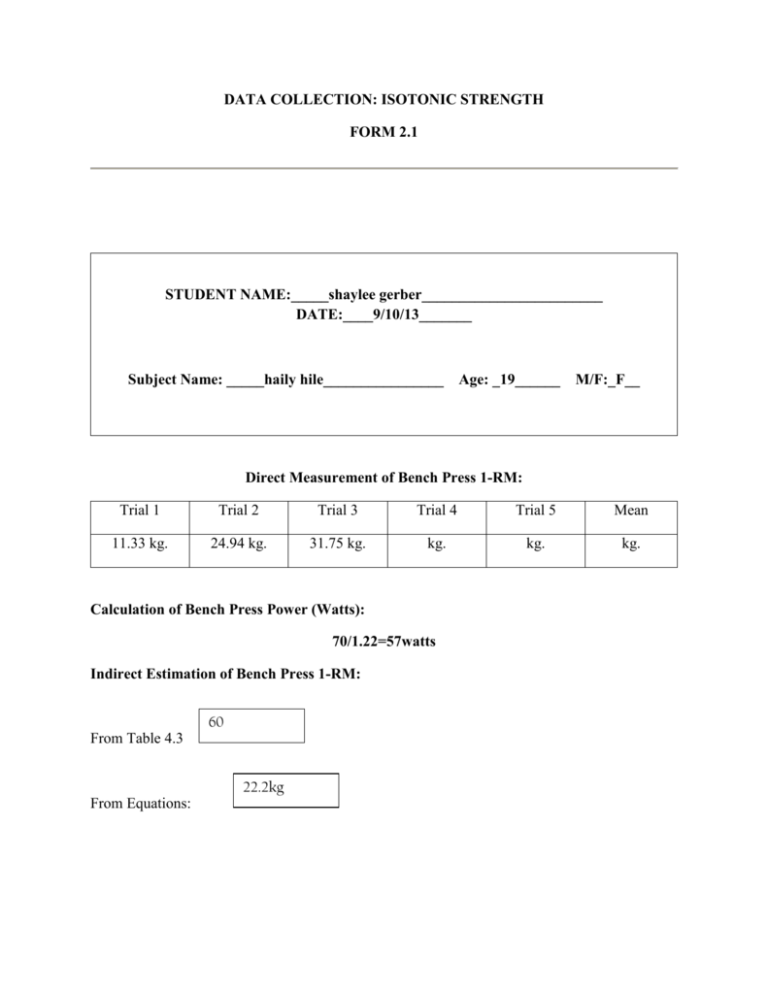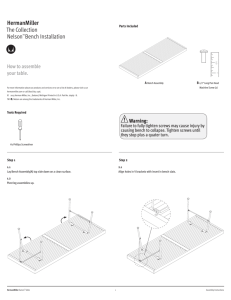File - Shaylee Gerber
advertisement

DATA COLLECTION: ISOTONIC STRENGTH FORM 2.1 STUDENT NAME:_____shaylee gerber________________________ DATE:____9/10/13_______ Subject Name: _____haily hile________________ Age: _19______ M/F:_F__ Direct Measurement of Bench Press 1-RM: Trial 1 Trial 2 Trial 3 Trial 4 Trial 5 Mean 11.33 kg. 24.94 kg. 31.75 kg. kg. kg. kg. Calculation of Bench Press Power (Watts): 70/1.22=57watts Indirect Estimation of Bench Press 1-RM: 60 From Table 4.3 22.2kg From Equations: Direct Measurement of Leg Press 1-RM: Trial 1 Trial 2 Trial 3 Trial 4 Trial 5 Mean 52.16 kg. 58.96 kg. 61.23 kg. kg. kg. kg. Calculation of Leg Press Power (Watts): 135/1.47=91.83watts Indirect Estimation of Leg Press 1-RM: 140 From Equations: DATA COLLECTION: ISOMETRIC STRENGTH FORM 2.2 Grip Strength Measurement Dominant hand: Seated Standing Trial #1 30kg 25kg Trial #2 25kg 23kg Trial #3 22kg 20kg Best Score 30kg Trial #3 21kg 21kg Best Score 21kg 21kg Non-dominant hand: STUDENT NAME shaylee gerber___________________ DATE:9/10/13________ Subject Name: ______Haily hile___________________ Age: ___21_____ M/F:__F__ Seated Standing Trial #1 20kg 20kg Trial #2 19kg 15kg LABORATORY REPORT 2 Measurement of Isotonic Strength & Power, Isometric Strength NAME: shaylee Gerber SECTION I: INTRODUCTION (5 points) Should include: overview of this lab (not including results an analysis), purpose of lab, importance of this lab, definitions of important terms and concepts used in this lab. - Measurement of Isotonic and Isometric strength was about muscle strength using a bench press. Leg press, as well as grip strength test. This was a test of a one rep max to find the amount of weight you can lift in the leg and bench press. The grip strength test was done using the best score of three. Finding the value of hand grip strength. The purpose of this lab was to see the amount of strength you can lift at your maximum weight. SECTION II: REVIEW OF LITERATURE (10 points) Include a summary of an article from a peer-reviewed journal which deals with the topic of the laboratory (in this case, measurement, validity, reliability of laboratory measurements, sources of error). Be sure to make reference to your source in AMA format and be sure to relate it to this laboratory exercise. To determine the reliability of Isotonic (1RM) strength measures of the triceps muscle on the non-dominate arm and its correlation with isokinetic and isometric strength measures. Measurements: Isotonic strength (kg) was measured using a 1 RM during a triceps press down exercise on a Universal Gym weight stack. The isokinetic and isometric tests measured triceps force (N) using a Biodex System 3. The isokinetic test required the subjects to maximally contract the biceps and triceps concentrically through a full range of motion ([is greater than or equal to] 120 [degrees]) for 3 repetitions. Isokinetic, and Isometric measures of maximal triceps strength appear to be reliable but not interchangeable. It appears that the three methods measure different aspects of maximal strength. The moderate correlation of isokinetic and isometric peak torque may be because isokinetic peak torque occurred near the position of isometric testing. SECTION III: METHODS (5 points) Include characteristics of your subject (gender, age, overall health and fitness level). This section represents a “cookbook” of exactly what you did (past tense is used). It should include the equipment/instruments used, and the procedure you used to obtain your measurements (although it SHOULD NOT include the actual results). It should also include any arithmetic procedures you did (e.g. averaging three scores). - My subject was a twenty one year old female in good health and fitness level. In the first test was the bench press test. This was a 1 rep max test trying to find the maximum amount of weight you can lift. This was done using the machine chest press. The procedure used to find this was a test of the amount of weight you can move until you can only lift it one time. This was an average of three scores. The leg press was done using the machine leg press. This was taken over an average of three times. The last rep that the subject lifted was also timed to see how long it took to lift the weight in both the bench and leg press. An Indirect estimation of the bench press and leg press using the 1 rep max was also done using the provided tables. The grip strength test was done using dynamometer. This test was done over best of three tries. The test was done sitting as well as standing, in both dominate and non-dominate hands to be able to compare the difference. SECTION IV: RESULTS (5 points) Simply report your results here – there is no analysis or interpretation in this section. You simply report what your measurements were. Graphs, when required, should be included in this section. Include any reporting forms (e.g. Form 1.1) in this section. - For the bench press test the subjects result was a one rep max of 70 pounds or 31.75kg in one minutes and twenty two seconds. The indirect estimation of the bench press test was 60. From the equation of the indirect estimation was 22.2kg. The bench press power was also determined a found to be 57 watts. The leg press test results was a one rep max of 135 pounds or 61.23 kg in one minutes and forty seven seconds. The indirect estimation of the leg press equation was 140kg. The leg press power was found to be 91.8 watts. The grip test results in the dominate hand seated was 30kg and standing was 25kg. The non-dominate hand seated was 21kg and standing was 21kg. SECTION V: DISCUSSION/ANALYSIS (10 points) Here’s where you get to discuss WHY you got the results that you did. What are some possible explanations for the results that you obtained? Did your results reflect the changes you would expect to see? Why would you expect the changes to occur in a particular way? - In the bench press I got the results I did because my subject had an idea of the amount of weight she could lift and tested the amount until she reached an amount that she could only do once. Possible reasoning for the amount of weight she lift could be that she warmed up and then tested other weights so she only reached the weight of 70 pounds or 31.75 kg. I would have expected her to lift more weight since it took her no time at all to lift that amount. The changes could have been changed if she had started at the 70 pounds she might have lifted more. In the leg press she only lift 135 pounds of 61.23kg she tried this lift three times being down the amount of weight she might have been able to lift. My subjected also warmed up in this test and practiced differing the amount of weight she might have been able to lift. Both of these test could have been error of effected due to the warm up, and practiced lifts before we found the one rep max. The hand grip test was a best of three scores standing and sitting using both hands I would say I got different results between standing and sitting due to stability. One was more stable than the other making it easier to squeeze the dynamometer. Using both hands let us see the difference in dominate and non-dominate hand. This showed witch was dominate and non-dominate in the test and allowed us to compare. I think the test came out the way I expected it to. SECTION VI: CONCLUSIONS/IMPLICATIONS (5 points) Summarize (not just repeat) your findings and conclusions here. What are the practical uses of your findings, i.e. how can others use what you found in this study? Did your findings here give you ideas for further research in a related topic? - My findings were that over three times her bench press test was 70 pounds or 31.75kg was her one rep mas and her leg press was 135 pounds or 61.23 kg. Both of these weights could have been effected by the warm up and the practice runs before trying to max weight. So there is a margin of error. The grip test was done by dominate and non-dominate hands, in sitting and standing positions, over the three tries. Both of the non-dominate hand test equaled 21kg standing and sitting and then in the dominate hand sitting was 30kg and standing was 25kg. The use of this lab would be beneficial for getting stronger or compare and contrast over an amount of time. It could also be used to train and met a new goal. REFERENCE: Cite the reference you used in Section II in AMA format. An example follows here: Rubley MD. Reliability And Correlation Of Maximal Isotonic (1 RM), Isokinetic, And Isometric Strength Measures Of The Triceps. Journal of Athletic Training. April-June, 2001. Available at Vol.36 (2), p.S-104. Accessed September 20,2013 SAVE YOUR COMPLETED REPORT AS A WORD DOCUMENT WITH THE FOLLOWING NAME: YOURLASTNAMELABREPORT1 For example, mine would be Huntingtonlabreport1 Place your completed report in the Laboratory 1 dropbox by the deadline.





